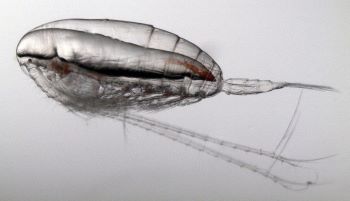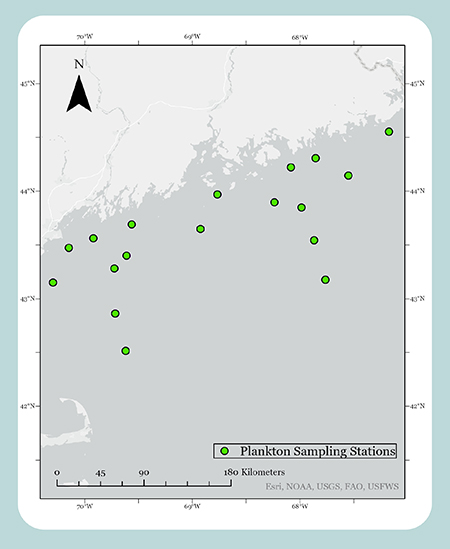
Copepods, a type of zooplankton, are a critical food source for North Atlantic right whales (NARWs) and changes in their distribution are through to drive changes in the distribution of NARWs, most notably in the Bay of Fundy and the Gulf of St. Lawrence. Specifically, the copepod species Calanus finmarchicus occurs in high abundances in the Gulf of Maine and are known for their large lipid sacs, making them excellent prey for NARWs.
This program is focused on habitat and prey related research to inform conservation and management of the endangered NARW in the Gulf of Maine. The goal of this program is to collect oceanographic and zooplankton data throughout the GoM to inform changes in the prey-scape of the North Atlantic right whale (primarily Calanus aggregations) and improve ecosystem models and predictive forecasting. Sampling is planned to start in July, 2025.

DMR will collect monthly samples allowing us to capture seasonal plankton dynamics and eventually look at interannual variability and correlations between plankton and other oceanographic parameters. Inshore stations are distributed along a North-South transect allowing us to sample the Maine Coastal Current, including Downeast stations that are historically under sampled. Additionally, offshore stations in the deep basins (Wilkinson Basin and Jordan Basin) will give us more information about diapausing (hibernating at depth) Calanus populations.
Our sampling program will utilize three pieces of oceanographic equipment to collect data:
- Bongo nets: towed vertically from 5-m off the bottom to the surface providing a zooplankton sample of the full water column. Samples will be processed for zooplankton community composition, biomass, and lipid content. The mesh size is 200um matching other ongoing sampling programs (MBON and Canadian AZMP programs).
- MultiNet: the multinet is a specialized piece of equipment that contains 5 zooplankton nets that can be shut at specific depths. This allows us to collect depth stratified samples and improve our understanding of dense Calanus aggregations and where they form in the water column.
- CTD with niskin bottles: sensors collect conductivity, temperature, depth, dissolved oxygen, pH, and fluorescence. Water from bottle samplers will be processed for chlorophyll and nutrients. These parameters are likely important in understanding changing plankton dynamics.